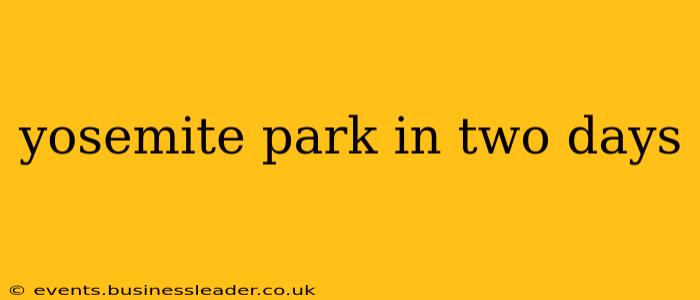Yosemite National Park, a breathtaking tapestry of granite cliffs, giant sequoia trees, and cascading waterfalls, is a destination that begs to be explored. While a two-day trip might feel rushed for such a vast and awe-inspiring place, it's entirely possible to experience its highlights with careful planning. This itinerary focuses on maximizing your time to see the most iconic landmarks and enjoy the park's unparalleled beauty.
Before You Go: Essential Planning
Before embarking on your Yosemite adventure, several crucial steps will significantly enhance your experience.
- Reservations: Yosemite requires reservations for entry during peak season (May-September). Secure your entry pass well in advance to avoid disappointment. Check the official Yosemite National Park website for the most up-to-date information on reservation requirements.
- Accommodation: Book your accommodation early, as options within the park fill up quickly. Consider lodging outside the park and commuting in, which can offer more affordable choices.
- Transportation: Decide how you'll navigate the park. Driving is convenient but parking can be challenging near popular sites. The free shuttle system is a great option, especially during peak season. Consider biking, too, for a more active experience.
- Packing: Pack layers of clothing, comfortable walking shoes are essential, sunscreen, a hat, sunglasses, and plenty of water.
Day 1: Yosemite Valley Icons
This first day focuses on the iconic sights of Yosemite Valley, the heart of the park.
Morning: Start your day early with a visit to Yosemite Valley Visitor Center. Grab a map, learn about the park's history and ecology, and plan your day accordingly. Then head to Tunnel View, for a breathtaking panoramic vista of El Capitan, Half Dome, and Bridalveil Fall.
Midday: Drive or take the shuttle to Bridalveil Fall. A short, easy paved trail leads to the base of this stunning waterfall. Afterwards, explore the Yosemite Valley Chapel, a charming historical landmark.
Afternoon: Spend the afternoon exploring El Capitan Meadow. Find a spot to enjoy a picnic lunch while soaking in the views of El Capitan. You can also hike a portion of the Mist Trail, leading to Vernal Fall and Nevada Fall (choose a portion depending on your fitness level and time constraints). This trail can be strenuous, so check the conditions and your abilities beforehand.
Evening: Enjoy sunset from a vantage point overlooking Yosemite Valley. Consider a ranger program for an insightful experience.
Day 2: Giant Sequoias and High Country Views
Today’s itinerary ventures beyond Yosemite Valley to discover the park’s giant sequoias and stunning high-country vistas.
Morning: Drive to Mariposa Grove of Giant Sequoias. This grove contains hundreds of these majestic trees, some of the largest living organisms on Earth. Take your time walking among them on the paved trails. This visit could easily take several hours.
Afternoon: Depending on time and energy levels, choose between exploring other areas of the park. Options include Glacier Point (offers incredible valley views but requires a long drive or shuttle), or a hike to a less crowded waterfall.
Evening: Consider another sunset viewing point, or if you're leaving the park, begin your journey home.
Frequently Asked Questions (PAAs)
How much time do I need to see Yosemite National Park?
Ideally, several days are needed to fully experience Yosemite National Park. However, a well-planned two-day trip can still allow you to see many of the highlights. This itinerary prioritizes the most iconic sights.
What are the best things to do in Yosemite in two days?
In two days, prioritize visiting Yosemite Valley (Tunnel View, Bridalveil Fall, El Capitan Meadow), and Mariposa Grove of Giant Sequoias. Choose one or two additional activities based on your interests and fitness level, such as a hike to a waterfall or visiting Glacier Point (if time permits).
Is two days enough time to see Yosemite?
Two days allows for a taste of Yosemite's highlights, but it’s a whirlwind tour. You will miss many trails, viewpoints and activities. It's enough to create a desire to return for a longer trip!
What is the best time to visit Yosemite National Park?
Shoulder seasons (spring and fall) offer pleasant weather and fewer crowds than summer. Summer brings warm weather but is the busiest time, requiring reservations. Winter can be beautiful but involves snow and limited accessibility to some areas.
What should I pack for a trip to Yosemite?
Pack layers of clothing, comfortable hiking shoes, sunscreen, a hat, sunglasses, water bottles, rain gear (especially in spring and fall), and any necessary medications. Consider bringing binoculars for wildlife viewing.
This itinerary provides a framework for experiencing Yosemite's majesty in two days. Remember to check the official park website for the most up-to-date information, trail conditions, and any necessary closures before your visit. Enjoy your trip!
